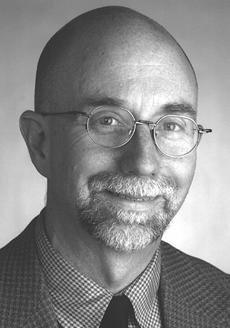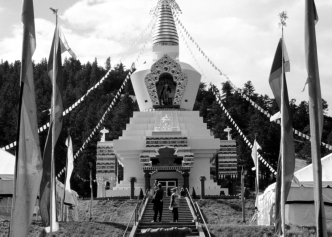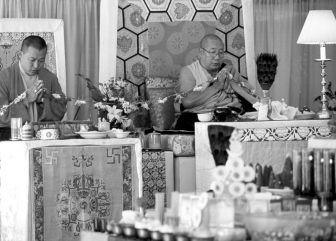| Site Visits from a Journalist’s Perspective |
![PDF-NOTE: Internet Explorer Users, right click the PDF Icon and choose [save target as] if you are experiencing problems with clicking.](http://rsnonline.org/templates/rsntemplate-smallmasthead/images/pdf_button.png) |
 |
Gustav Niebuhr, Syracuse University
On a spring day nearly a decade ago, I paid a visit to a small religious community that lived on a wooded property several miles up an undulating dirt road in the Ozarks. Two rather serious-looking young men met me as I emerged from my car and, with a minimum of small talk, escorted me to meet the group’s patriarch. The interview focused mostly on the community’s unique beliefs: that people of Northern European ancestry primarily comprised biblical Israel’s true heirs, and that apocalyptic events lay in store for the United States. At one point, he suggested that someone had the community under surveillance; not long before, he said, a “black helicopter” had been spotted hovering low overhead. Local law enforcement officials later told me they knew nothing about this. But it had been an exceptionally violent month in that particular region. Four weeks earlier, Timothy McVeigh had bombed the Oklahoma City federal building. The same day, the state of Arkansas had executed a white supremacist for the murder of a state trooper. I cite this experience not for its details, which still strike me as exotic as I read through my report of that visit, but rather because its essential elements typify my work as a journalist, which involved visiting religious sites around the country. Before I came to Syracuse University in January 2004, I spent much of the previous twenty years working as a newspaper journalist, covering religion in America in all its great diversity. From 1994 until the end of 2001, I worked for the New York Times and, prior to that, the Washington Post and the Wall Street Journal. Visiting religious sites was an important part of my job. I was expected to interpret for a general audience the varied forms religion takes in the United States. My visits were not random, but occurred after my editors and I agreed that the places and people I would see had value as “news” — such as, if a community were engaged in some legal or political issue, or if the site in question represented part of a major trend. Often, as in my visit to the group in the Ozarks, I had a relatively short time to gather information at the site itself. But there were times when I had the luxury of a longer visit, such that I could return to the site over the course of two, three, or more days, asking follow-up questions, noting details I had missed, and gathering printed material to read in the off-hours. I write this essay as I prepare to teach a course on religious pluralism. I expect to include visits with my students to local houses of worship. My journalistic experiences ought to prove useful, but I expect to make changes in my approach, as I will note below. One practice I will certainly retain is calling ahead before visiting a site. As a journalist, I found it far better to establish a cursory relationship with the primary person or people I wanted to interview before I arrived. Rarely, I believed, would I gain anything by taking someone by surprise. I recall trying it once in 1988 and found it unproductive, to say the least. At a minimum, not making contact in advance runs the risk of wasting time, since one ends up negotiating to arrange interviews at the scene. The articles I wrote always required some description of the site itself, as well as the activities carried out there, written to be accessible to a general reader. But I rarely thought my own observations ought to stand alone. I relied on the people I encountered to interpret from their own experience the spiritual dimensions of the place and to describe the value of the activities occurring there. Once, at the Times, I proposed a series of stories on the rise of evangelical Protestant megachurches, which typically attract upwards of 2,000 people a week to services. I wrote three stories, which focused on the clergy, the congregations, the activities within those churches, and the organizational ideas that fostered their growth. My editors asked the Times lead architecture critic to write a fourth story, But otherwise, I worked on my own and tended to be most interested in how people experienced a given site. This required me to give their words a standing equal to my own observations. In August 2001, when I attended the consecration of an imposing Buddhist stupa in an alpine meadow tucked among the high peaks of the Colorado Rockies, I wanted to include as many voices as I could, while bearing in mind I would be describing a structure utterly unfamiliar to most Times readers. The Great Stupa of Dharmakaya contained the ashes of Chogyam Trungpa Rinpoche, a Tibetan exile who had spent two decades teaching in the West, during which time he founded Naropa University in Boulder. Despite the site’s remoteness, two hours’ drive west of Fort Collins, the ten-day event had a richly cosmopolitan feel, with 2,000 people attending, some from as far away as Britain and India. The ceremony stood as a rite of passage for Tibetan Buddhism in the United States, in its emergence as an established faith, and this, too, had to be noted. What follows is a brief passage from my story: For some, the stupa symbolizes a new stage in Buddhism’s American development. “It seems to me,” said Judith Simmer-Brown, chairwoman of Naropa’s religious studies department, “in the 70s, Buddhism was more of a sect.” But by creating such monuments, she said, “we’re moving into a culture and a civilization.” A stupa is a traditional monument, and in this form is a highly stylized rendering of the Buddha seated in meditation. “A stupa represents the heart of the Buddha,” said Zurmang Gharwang Rinpoche of Sikkim, India, who was among more than 50 monks who traveled to the consecration from Asia. “That means,” he said, “when you’re close to the stupa, you’re close to the Buddha.” (Gustav Niebuhr, “Towering Buddhist Shrine Is Consecrated in the Rockies,” New York Times, August 20, 2001, 12.) I spent two days at the consecration and thus had the opportunity to look carefully at the structure, to check my initial notes, and to make new ones. More typical was the experience I had seven weeks later — post-9/11 — when I paid a nearly spur-of-the-moment visit to a tiny mosque in Fayetteville, North Carolina. I was one of several Times reporters dispatched around the country to write about military communities on the eve of soldiers’ deployment to Afghanistan, and I had just finished spending a week outside of Fort Bragg. The mosque I visited, housed in a small, neatly kept building, was called the Masjid Omar ibn Sayyid. It served a largely African-American community. That several of those who attended When I teach my upcoming course on religious pluralism, I expect to make considerable adjustments in my approach to visiting religious sites. I will certainly want to step back from the central role I’ve had to take as a journalist. I want to encourage my students to make their own observations and to ask the questions they believe most necessary to understanding the places we visit. Rather than being the arbiter of what available information about a site is presented to a wider audience, I look forward to a more collaborative experience of discovery and learning. |


 Gustav Niebuhr is Associate Professor of Religion and Media in the Department of Religion at Syracuse University. His acclaimed coverage of American religion has appeared in the New York Times, Washington Post, and Atlanta Journal/Constitution. He is working on a book about religious pluralism and interfaith relations in America.
Gustav Niebuhr is Associate Professor of Religion and Media in the Department of Religion at Syracuse University. His acclaimed coverage of American religion has appeared in the New York Times, Washington Post, and Atlanta Journal/Constitution. He is working on a book about religious pluralism and interfaith relations in America. describing the physical styles of some of these new buildings. Our stories complemented one another. [Gustav Niebuhr, “Where Religion Gets a Big Dose of Shopping Mall Culture,” New York Times, April 16, 1995, p. 1; “The Minister as Marketer: Learning from Business,” New York Times, April 18, 1995, p. 1; “Protestantism Shifts Toward a New Model of How ‘Church’ Is Done,” New York Times, April 29, 1995, p. 12; and Paul Goldberger, “The Gospel of Church Architecture, Revised,” New York Times, April 20, 1995, Section C, p. 1.]
describing the physical styles of some of these new buildings. Our stories complemented one another. [Gustav Niebuhr, “Where Religion Gets a Big Dose of Shopping Mall Culture,” New York Times, April 16, 1995, p. 1; “The Minister as Marketer: Learning from Business,” New York Times, April 18, 1995, p. 1; “Protestantism Shifts Toward a New Model of How ‘Church’ Is Done,” New York Times, April 29, 1995, p. 12; and Paul Goldberger, “The Gospel of Church Architecture, Revised,” New York Times, April 20, 1995, Section C, p. 1.] were either soldiers or army veterans struck me as the sort of information Times readers might not expect, especially given the widespread cultural unease about Islam itself that was so evident that autumn. My visit was of necessity short, as I was expected to file a story by late afternoon. I attended Friday prayers and interviewed the Imam, along with four or five other men who had come by (there were hardly any women present that Friday). Given the 700-word limit I faced that day, I had to be very selective in what I could include. But in addition to quoting from the sermon, including comments from individual Muslims about their relationship to the army and their thoughts on the coming war, I wanted to include at least one physical detail I thought salient — that the mosque’s lobby contained a table stacked with copies of an American Muslim newspaper bearing the headline “G-d Bless America.” It also seemed relevant to understanding this particular mosque’s identity to mention that it had been named after an American figure, a North Carolina slave who wrote an autobiographical letter in 1831 describing his upbringing as a Muslim in West Africa.
were either soldiers or army veterans struck me as the sort of information Times readers might not expect, especially given the widespread cultural unease about Islam itself that was so evident that autumn. My visit was of necessity short, as I was expected to file a story by late afternoon. I attended Friday prayers and interviewed the Imam, along with four or five other men who had come by (there were hardly any women present that Friday). Given the 700-word limit I faced that day, I had to be very selective in what I could include. But in addition to quoting from the sermon, including comments from individual Muslims about their relationship to the army and their thoughts on the coming war, I wanted to include at least one physical detail I thought salient — that the mosque’s lobby contained a table stacked with copies of an American Muslim newspaper bearing the headline “G-d Bless America.” It also seemed relevant to understanding this particular mosque’s identity to mention that it had been named after an American figure, a North Carolina slave who wrote an autobiographical letter in 1831 describing his upbringing as a Muslim in West Africa.